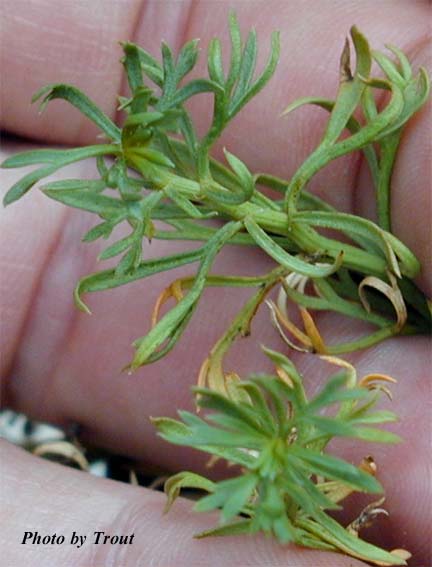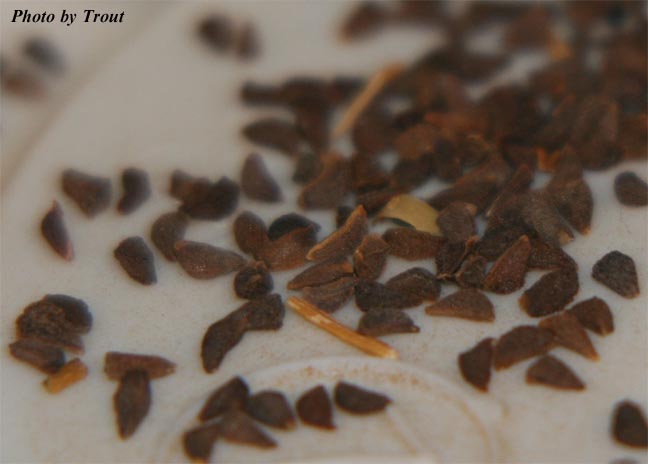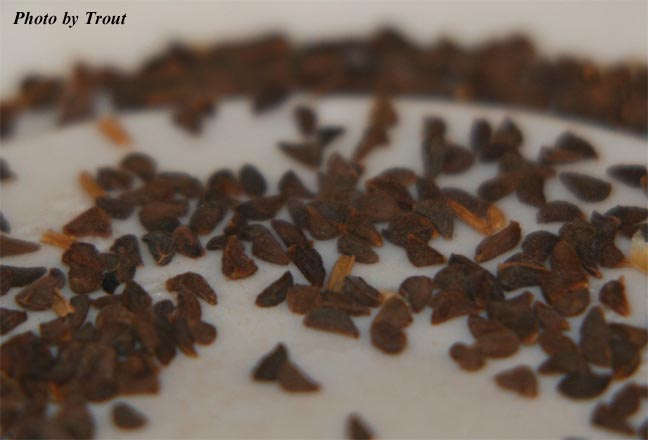Ayahuasca: alkaloids, plants & analogs
Section 2 :
Peganum harmala Linnaeus

Earliest botanical description:
Peganum harmala Linnaeus, Sp Pl. (1753): 444.
Schultes 1979c
"Harmal"
Undershrub growing on sandy-loam. Moist soils in warm places (Saudi Arabia).
Abulafatih 1987 claims that swallowing the seeds produces hallucinations and sexual excitement; citing Hooper & Field 1937. All of whom I suspect had never ingested the seeds.
-
Common names:
- North Africa: Harmel, Mejennena, Basasa
- Arabian : Hharmal, Armel
- English : Syrian rue, Wild "rue" (although unrelated to true rue)
- French : Harmale, Rue sauvage.
- German : Steppenraute, Harmelraute.
- Indian: (Hindi): Gandhya, Harmal; (Bengalese): Isband, Ispand; (Bombay): Hurmal.
- Italian : Armel, Pègano, Ruta siriaca.
- Persian : Isband, Ispand.
- Spanish : Gamarza, Alharmaga, Estacarrocines.
- Formerly known as "Ruta silvestris"
- Hocking 1966 and Samorini 1994.
Also called: "PEGANON AGRION. Peganum harmala . But some call Ruta Sylvestris, ..., is called Moly....But some call it Harmala, ye Syrians Besasa (ye Egyptian Epnubu, Africans Churwa), ye Cappadocians Moly."
- From Holmstedt 1982 in Bloom 1982. Taken from Dioscorides; as quoted by Gunther 1934.
New Delhi: hermal First mentioned as a hallucinogen, probably experienced by Engelbert Kaempfer while in Persia, in the first review of hallucinogens ever published, called Inebriantia, written by a student of Linnaeus named Olof R. Alander.
- From Holmstedt 1982 cited Alander 1761 Inebriantia. Dissertation Uppsala.
From Degtyarev et al. 1984 Chemistry of Natural Compounds 20 (2): 240-241:
Degtyarev et al. 1984 found harmine and harmaline together to form only 25% of the total alkaloids present in the ripe fruit but 75% of the total alkaloid present in the green fruit (Collected in Yagnob Basin, Tadzhikistan during July)
Total alkaloid content was higher in ripe than unripe fruit but profiles were different so the actual total harmine yield was far higher in the unripe fruit.
Ripe seeds were found to contain 0.9% harmine and 0.6% harmaline.
Green seeds were found to contain 4.3% harmine and 0.28% harmaline.
Peganine was present as 40% of the total alkaloid in the ripe fruit (2.5% peganine) but only 5% of the total alkaloid in the green fruit (0.28% peganine).
Deoxyvascicinone was present as 15% of the total alkaloid in the ripe fruit (0.9%) and 5% in the green fruit (0.28%).
The stems were found to have Deoxyvascicinone as the major alkaloid with harmine present at 0.06% and harmaline at 0.03%
They found harmine also to be the major alkaloid in the roots (1.38% harmine by weight; while harmaline was present at 0.12%). Peganine and deoxyvascicinone were present at 0.46% and 0.12 % respectively)
(All weights are percentage of dry material.)
Degtyarev and associates also looked at a sample collected in June in the Lyaura region and found similar levels of alkaloid in the root but with totals of nearly a percent less in both ripe and green fruit. Whether the difference was varietal, local, environmental or seasonal cannot be determined from their reported information.
Al-Shamma et al. 1981 reported Harmine, Harmaline, Vasicine & Deoxyvasicinone in the seeds.
Chatterjee & Ganguly 1968 reported the seeds to contain 0.3% Harmine, 0.001% Harmaline, a third alkaloid that they did not identify & 0.008% Deoxyvascinone.
From Ott 1993 Pharmacotheon pages 204-205:
b-carbolines were found in highest concentrations in the mature seeds. Ranging from 2 to 7%.
Roots range from 1.4 to 3.2%
Citing Kutlu & Amal 1967 and al-Shamma &
Abdul-Ghany 1977.
Ratio of harmine to harmaline is seasonal;. Usually harmine is the major alkaloid.
In roots:
Winter was time of highest alkaloid level. Harmine 1.8% / Harmaline 0.4%.
Summer showed a lower alkaloid total. i.e. Harmine 0.6%/ Harmaline 0.8%
Citing Kashimov et al. 1971 and Safina et al. 1970.
A similar phenomena has been seen in the seeds:
Winter had highest overall concentration of alkaloid.
Harmaline was twice the level of harmine in the winter while harmine was about twice the levels of harmaline in the summer.
Citing Kamel et al. 1970.
Considerable geographical variations has been observed. Iraqi plants have been reported which had twice the alkaloids of Soviet plants. Citing Khashimov et al. 1971 and Safina et al. 1970 and al-Shamma & Abdul-Ghany 1977.

Review of harmane alkaloidal chemistry in:
Flattery & Schwartz 1989.
See also Khashimov et al. 1971.
Ott 1993 has more on usage and other compounds. See pp. 200-206
Harmine, harmaline and harmalol are the major alkaloids in the seeds, seedlings and in callus grown on auxin-deficient medium.
Ruin was reported from both seedlings and callus derived from the roots and hypocotyls.
Other alkaloids present in seedlings include harmol, dihydroruine, and Gentisate 2,5-b-diglucoside. All were present in callus grown on auxin-deficient medium as was traces of 5-HT. 6-Hydroxytryptamine was observed in seeds, seedlings and callus grown on auxin-deficient media but only in material produced from seed originating in Dijon.
Widely used as incense.
Burned to repel the evil eye, to dispel bad fortune, effect prognostication and to bring success and good luck.
Seeds used as an antidote for demonic possession. Samorini 1994
Peganum harmala bark is used for abortion in India. Tarafder 1983b
Reported to demonstrate anti-tumor activity (cytotoxic against melanoma), wheat rootlet growth inhibition and "strong growth inhibition (above 96%) of the malaria parasite Plasmodium falciparum" Golan-Goldhirsh et al. 1999
Used as an antiseptic and for skin diseases since antiquity. Its smoke has been employed as a disinfectant [Al-Shamma et al. 1981 cited Telezhenetskaya & Yu 1977]
Found to be an active antimicrobial agent (harmine was determined to be the active component)
See Al-Shamma et al. 1981 & Al-Shamma & Mitscher 1979
"The most prominent worker in plant chemistry in Dorpat was George Dragendorff. In his classical work "Die Heilpflanzen." (1967, orig 1898) he says about Peganum harmala the following:
"It grows in Southern Europe and the Orient. The seeds were already being used by the Greeks against ophthalmic diseases and, later on, as a diaphoretic, emmenagogue, antihelmintic as well as an intoxicant and hypnotic (like Cannabis indica )."
Holmstedt 1982 citing Dragendorff 1967 (originally published 1898)

- Also use the search engines at:

